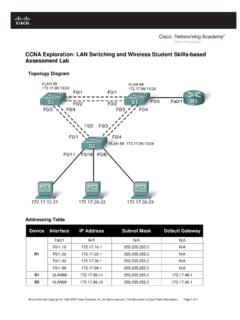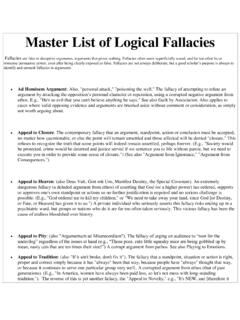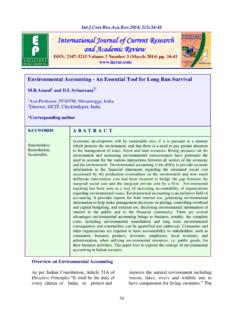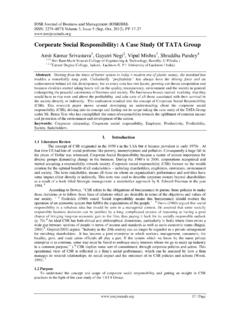Transcription of The Pyramid of Corporate Social Responsibiiity: …
1 The Pyramid of CorporateSocial responsibiiity : Towardthe Morai management ofOrganizational StakeholdersArchie B. CarrollFor the better part of 30 years now, corpo-rate executives have struggled with theissue of the firm's responsibility to its soci-ety. Early on it was argued by some that thecorporation's sole responsibility was to provide amaximum financial return to shareholders. Itbecame quickly apparent to everyone, however,that this pursuit of financial gain had to takeplace within the laws of the land. Though socialactivist groups and others throughout the 1960sadvocated a broader notion of Corporate respon-sibility, it was not until the significant Social legis-lation of the early 1970s that this message be-came indelibly clear as a result of the creation ofthe Environmental Protection Agency (EPA), theEqual Employment Opportunity Commission(EEOC), the Occupational Safety and Health Ad-ministration (OSHA), and the Consumer ProductSafety Commission (CPSC).
2 These new governmental bodies establishedthat national public policy now officially recog-nized the environment, employees, and consum-ers to be significant and legitimate stakeholdersof business. Erom that time on, Corporate execu-tives have had to wrestle with how they balancetheir commitments to the corporation's ownerswith their obligations to an ever-broadeninggroup of stakeholders who claim both legal andethical article will explore the nature of corpo-rate Social responsibility (CSR) with an eye to-ward understanding its component parts. Theintention will be to characterize the firm's CSR inways that might be useful to executives whowish to reconcile their obligations to their share- Social responsibilitycan only becomereality if more man-agers becomemoral instead ofamoral or with those toother competing groupsclaiming discussion will beframed by a Pyramid ofcorporate Social respon-sibility.
3 Next, we planto relate this concept tothe idea of stakehold-ers. Einally, our goalwill be to isolate theethical or moral compo-nent of CSR and relateit to perspectives thatreflect three major ethical approaches to manage-ment immoral, amoral, and moral. The princi-pal goal in this final section will be to flesh outwhat it means to manage stakeholders in an ethi-cal or moral OF CORPORATESOCIAL RESPONSIBILITYWhat does it mean for a corporation tobe socially responsible? Academics andpractitioners have been striving to estab-lish an agreed-upon definition of this concept for30 years. In I960, Keith Davis suggested thatsocial responsibility refers to businesses' "deci-sions and actions taken for reasons at least par-tially beyond the firm's direct economic or tech-nical interest.
4 " At about the same time, Eells andWalton (196I) argued that CSR refers to the"problems that arise when Corporate enterprisecasts its shadow on the Social scene, and theThe Pyramid of Corporate Social Responsibility39 Figure 1 Economic and Legal Components of Corporate Social ResponsibilityEconomic Components(Responsibilities)1. It is important to perform in amanner consistent withmaximizing earnings per It is important to be committed tobeing as profitable as It is important to maintain a strongcompetitive It is important to maintain a highlevel of operating It is important that a successfulfirm be defined as one that isconsistently Components(Responsibilities)1.
5 It is important to perform in amanner consistent with expecta-tions of government and It is important to comply withvarious federal, state, and It is important to be a law-abidingcorporate It is important that a successfulfirm be defined as one that fulfillsits legal It is important to provide goodsand services that at least meetminimal legal , had to address the entirespectrum of obligations business has tosociety, including the most fundamen-tal economic. It is upon this four-partperspective that our Pyramid is recent years, the term corporatesocial performance (CSP) has emergedas an inclusive and global concept toembrace Corporate Social responsibility,responsiveness, and the entire spectrumof socially beneficial activities of busi-nesses.
6 The focus on Social performanceemphasizes the concern for corporateaction and accomplishment in the socialsphere. With a performance perspective,it is clear that firms must formulate andimplement- Social goals and programs aswell as integrate ethical sensitivity intoall decision making, policies, and ac-tions. With a results focus, CSP suggestsan all-encompassing orientation towardsnormal criteria by which we assess busi-ness performance to include quantity,quality, effectiveness, and we recognize the vitality of theperformance concept, we have chosento adhere to the CSR terminology for ourpresent discussion. With just a slight change offocus, however, we could easily be discussing aCSP rather than a CSR Pyramid .
7 In any event, ourlong-term concern is what managers do withthese ideas in terms of Pyramid OF CORPORATEF ethical principles that ought to govern the rela-tionship between the corporation and society."In 1971 the Committee for Economic Devel-opment used a "three concentric circles" ap-proach to depicting CSR. The inner circle in-cluded basic economic functions growth, prod-ucts, jobs. The intermediate circle suggested thatthe economic functions must be exercised with a / Social RESPONSIBILITY sensitive awareness of changing Social values and /priorities. The outer circle outlined newly emerg-/ T~l or CSR to be accepted by a conscientiousing and still amorphous responsibilities that busi-ness should assume to become more activelyinvolved in improving the Social attention was shifted from Social respon-sibility to Social responsiveness by several otherwriters.
8 Their basic argument was that the em-phasis on responsibility focused exclusively onthe notion of business obligation and motivationand that action or performance were being over-looked. The Social responsiveness movement,therefore, emphasized Corporate action, pro-action, and implementation of a Social role. Thiswas indeed a necessary question still remained, however, ofreconciling the firm's economic orientation withits Social orientation. A step in this direction wastaken when a comprehensive definition of CSRwas set forth. In this view, a four-part conceptu-alization of CSR included the idea that the corpo-ration has not only economic and legal obliga-tions, but ethical and discretionary (philan-thropic) responsibilities as well (Carroll 1979).
9 The point here was that CSR, to be accepted asbusiness person, it should be framed insuch a way that the entire range of busi-ness responsibilities are embraced. It is suggestedhere that four kinds of Social responsibilities con-stitute total CSR: economic, legal, ethical, andphilanthropic. Furthermore, these four categoriesor components of CSR might be depicted as apyramid. To be sure, all of these kinds of respon-sibilities have always existed to some extent, butit has only been in recent years that ethical andphilanthropic functions have taken a significantplace. Each of these four categories deservescloser ResponsibilitiesHistorically, business organizations were createdas economic entities designed to provide goodsand services to societal members.
10 The profit mo-tive was established as the primary incentive forentrepreneurship. Before it was anything else, thebusiness organization was the basic economicunit in our society. As such, its principal role was40 Business Horizons /July-August 1991to produce goods and services that con-sumers needed and wanted and to makean acceptable profit in the process. Atsome point the idea of the profit motivegot transformed into a notion of maximumprofits, and this has been an enduringvalue ever since. All other business re-sponsibilities are predicated upon the eco-nomic responsibility of the firm, becausewithout it the others become moot consid-erations.
















